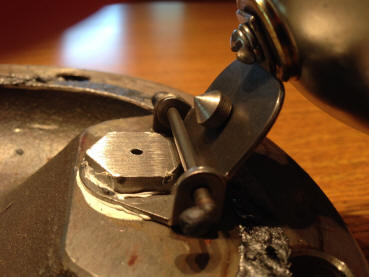- The Company
- Articles
- Coalescer Gas Liquid Separator Designs
- Comparison of Centrifugal and Vane Style Gas Liquid Separators
- Design & Capabilities of Gas Liquid Separators
- Differences of a Knock-Out Drum and Centrifugal Gas-Liquid Separator
- Exhaust Head Design
- How float drain traps work, installation and maintenance
- How to identify a Wright-Ausin Separator
- How to Size a Moisture Separator
- Steam Traps vs. Steam Separators
- Efficiencies of Centrifugal Separators
- Understanding Sizing Factors For Gas/Liquid Separators
- Horizontal
- Vertical
- High Solids
- Coalescer
- Elements
- Exhaust Heads
- Float drain traps
- Liquid level gauges
- Sizing Calculators
- Inquiries
Float Drain Traps
How they work, applications and maintenance
Float drain traps are a type of mechanically automated valve used to drain
liquids from piping systems without loss of process gas; they can also be used
to vent gasses from piping systems when during filling.
The most common use for
float drain traps are drainage of condensate from steam systems to maximize
energy efficiency and eliminate system upset conditions related to liquid slugs
and wear on system components sensitive to contaminated liquids containing pipe
scale and other foreign material. As
applied to steam systems, float drain traps are considered to be a type of steam
trap; whereas float drain traps are mechanical in nature other steam trap
designs are based upon thermostatic and thermodynamic design principles.
Float
drain traps are also used for other gaseous systems, most commonly compressed
air but there are many industrial gas processes resulting in condensation of
liquids which wear, corrode or otherwise impede the function of pipeline
components and degrade the overall process.
The water condensate within
compressed air systems often contains compressor oil in addition to pipe scale,
metal fines and elastomer contaminates.
The non-water condensate found within industrial gas systems are often
related to gas/liquid separators and both temperature and pressure fluctuations.
As with steam and compressed air systems, float drain traps enable
removal of these liquids without loss of process gas.
Float drain traps can also
be used as vents in support of centrifugal pump priming and quick filling of
large pipe systems which collect air while idle.
To use a float drain trap as a vent, the trap is installed “upside-down”,
where the outlet becomes the inlet and vice-versa.
Float drain traps are often
neglected and ignored, only noticed once they leak or fail to operate
altogether. It is not too surprising
given most float drain traps are installed in inaccessible locations and many
personnel do not truly understand how they operate, the best way to install
float drain traps, preventative maintenance requirements and how to repair them.
Proper installation and establishing a PM routine will enable float drain
traps to operate 24/7/365 for a decade or longer prior to requiring rebuilding
or replacement.
How Float Drain Traps Work
The liquid to be drained is denser
than the process gas and thus as it accumulates within the float drain trap
body, an internal float rises and lowers in accordance with the level of liquid
within the float drain trap. A
plunger style valve is attached to the float by means of a lever and fulcrum, so
as the liquid level rises the valve plunger is lifted off the valve seat,
allowing “overfill” of liquid condensate to drain from the trap.
Likewise, as the liquid level decreases the float lowers and enables the
valve to seal against its seat.
The internal components are constructed of a
non-magnetic stainless steel and thus the interface of the valve and seat is
metal-to-metal with one exception: the 1/8” orifice size is available with a
Viton grommet to promote a more resilient and longer lasting seal.
The tapered design of the valve enables it to seal against the four
standard valve seat orifice sizes (5/64”, 1/8”, 3/32” and 5/64”).
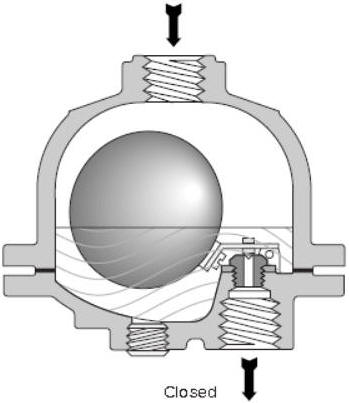
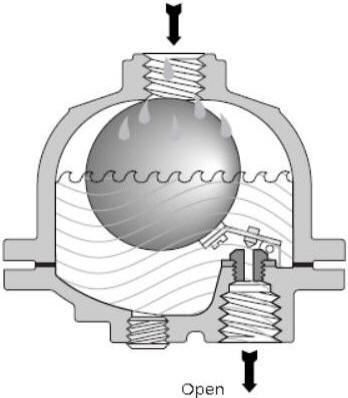
Larger valve
orifices correspond with higher drainage rates; smaller orifice sizes will
reduce cycle frequency and extend the wear life of the valve/seat.
At all times
there is a residual volume of fluid within the float drain trap acting as a
barrier between the process gas and discharge of the trap, ensuring no leakage
of the process gas during drainage.
When installed as a vent, the operation of
raising and lowering the internal float results in the same seating and
unseating of the valve except rising of the float seals the trap and the lower
position of the float unseats the valve to enable venting of the process
gas.
Proper installation of float drain traps
Float drain traps should be
installed 6” below the gas/liquid separator (or other vessel/pipe) drain.
Add 1” vertical distance for each 1” of horizontal plumbing going to the
drain trap inlet. The top of the
drain trap should never be above the drain unless you add a balance line
enabling the process gas to vent back into the system.
How do you know if your
trap is working?
The most accurate way to determine if your trap is functioning
properly is to visually confirm drainage of condensate; if you can see, hear or
smell your process gas escaping from the drain trap, the valve is not seating
properly. This is one reason why it
is important to install your float drain trap in an accessible location (which
also makes periodic maintenance easier.
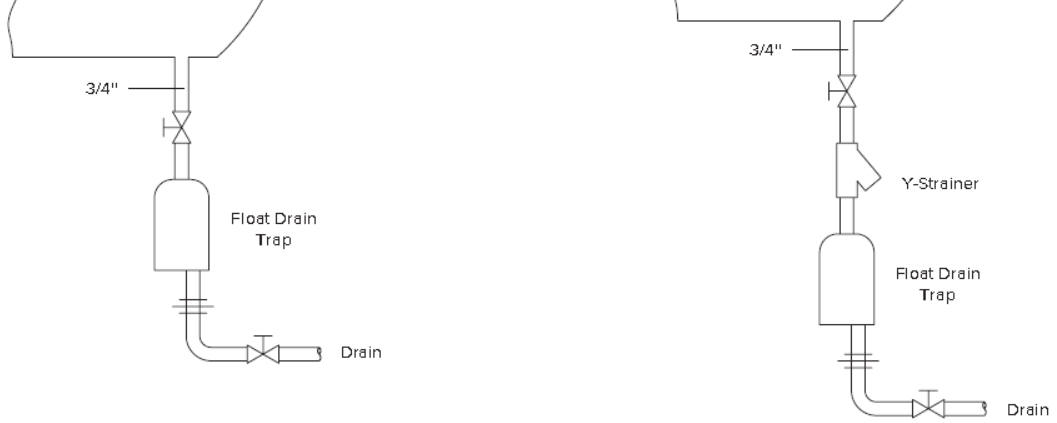
Float drain trap maintenance
Float drain
traps should be located such they can be observed and, if necessary, maintained.
Float drain traps have a blow-down plug to enable periodic clean-out of
pipe scale and other debris which accumulate within the trap body.
Installation of a Y strainer will reduce blow-down frequency and it is
generally easier to blow-down a Y strainer screen, especially when attaching a
ball valve to its blow-down port.
Occasionally your float drain trap will
require servicing and that will necessitate access to the flanged body to remove
the cap screws; all of the replaceable components are attached to the removable
portion of the float drain trap.
Causes of drain trap failure
The most common
failure is related to the wearing out of the valve and seat, resulting in
leakage of process gas. Your float
drain trap will typically operate for many years before the valve and seat
require replacement, but that can be accelerated by both cycle frequency and
material compatibility. Select a valve orifice size corresponding to slightly
larger than necessary to remove your maximum condensate volume based upon your
lowest operating pressure condition; we have charts to assist in this endeavor.
The valve and seat are made of 18-8 stainless steel.
If a trap containing
condensate freezes, the resulting expansion within the trap body can damage the
internal float, fulcrum or lever; in-fact it can also crack the drain trap body,
especially if it is made from cast iron.
Freezing can be prevented by installing a 120v 50w or 100w heater in trap
models having a corresponding threaded port allowing insertion into the trap
body.
Over-pressurization would be another cause for failure which could result
in damage to the trap body, gasket or internal float assembly.
Residual liquid
within the separator body will corrode the body itself.
If the trap will sit for long periods of time not in use, it is
recommended the liquid be drained.
The drain trap body should be periodically inspected for excessive corrosion
although in most cases the valve/seat will wear-out before the body becomes
severely corroded, so noting corrosion during valve/seat replacement is
typically sufficient.
How to repair float drain traps
Our float drain trap models
are very easy to repair; the repair kit contains all of the replaceable
components. First you remove the cap
screws holding the lower half of the float drain trap to the upper half; all of
the replaceable components are attached to the lower half.
Next, remove the
fulcrum pin to remove the float, lever and valve assembly.
You can now remove the valve seat and replace it with the new one.
A cotter pin is used to hold the valve onto the lever, so you can
swap-out valves accordingly.
Although each kit contains all the internal components, you will likely only
need to replace the valve and seat (or whatever was damaged).
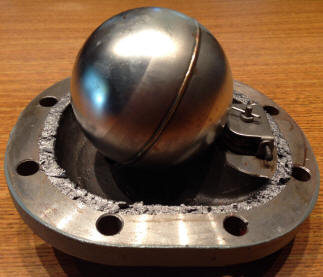
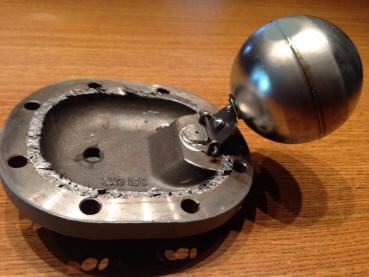
Cost of kits vs.
replacement
Unfortunately, the cost of the repair kit is nearly the same cost for
an entirely new cast iron float drain trap and it is not possible to purchase
individual components, so if the cast iron float drain traps are readily
available most customers simply replace the entire unit as it is more cost
effective to do so. The carbon steel
and stainless-steel float drain traps cost more, so the kit’s cost of 35-50%
compared to replacing the entire trap (a savings of >$1000) makes it the cost
savings choice. The float drain trap
bodies are cast in China and sometimes the lead time is long enough where
rebuilding them is the only viable option.
Float drain trap repair kit contents
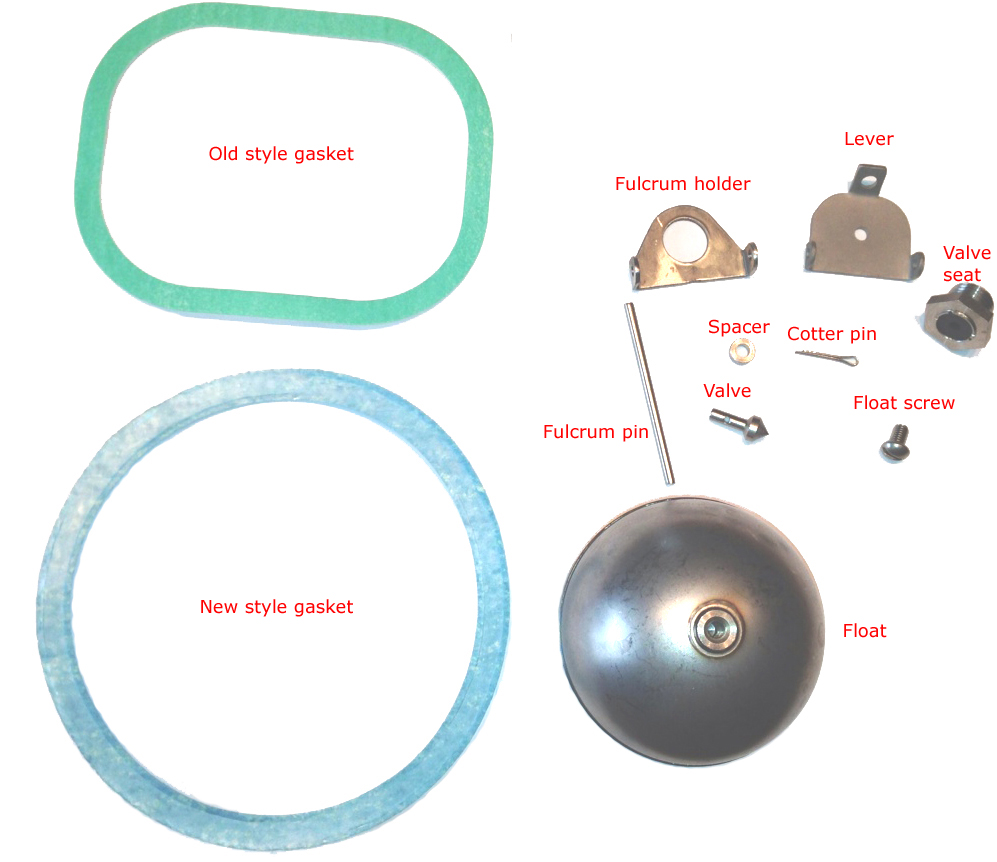
Problematic Applications
Float drain traps are not recommended for use in vacuum systems or when the liquid contains heavy oil, sludge and high concentrations of particles as all of these characteristics impede the proper functioning of the trap; for these applications and others requiring larger drain orifices we can suggest alternate designs.





